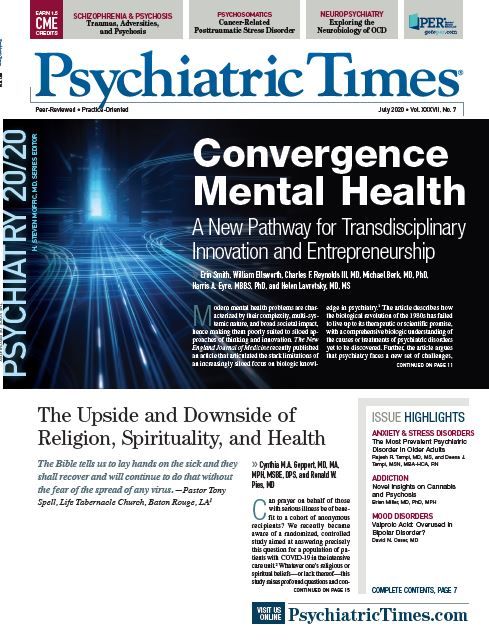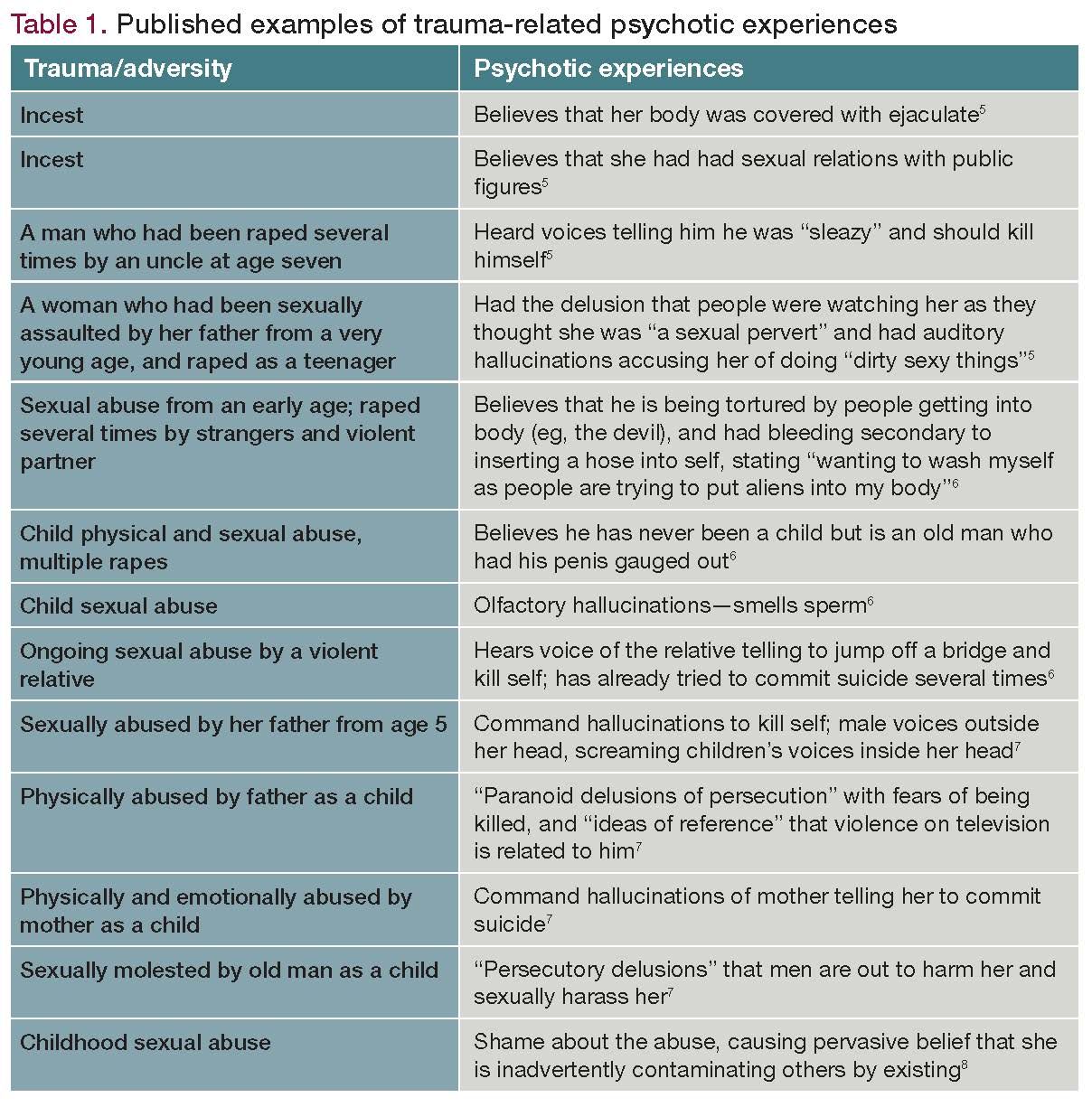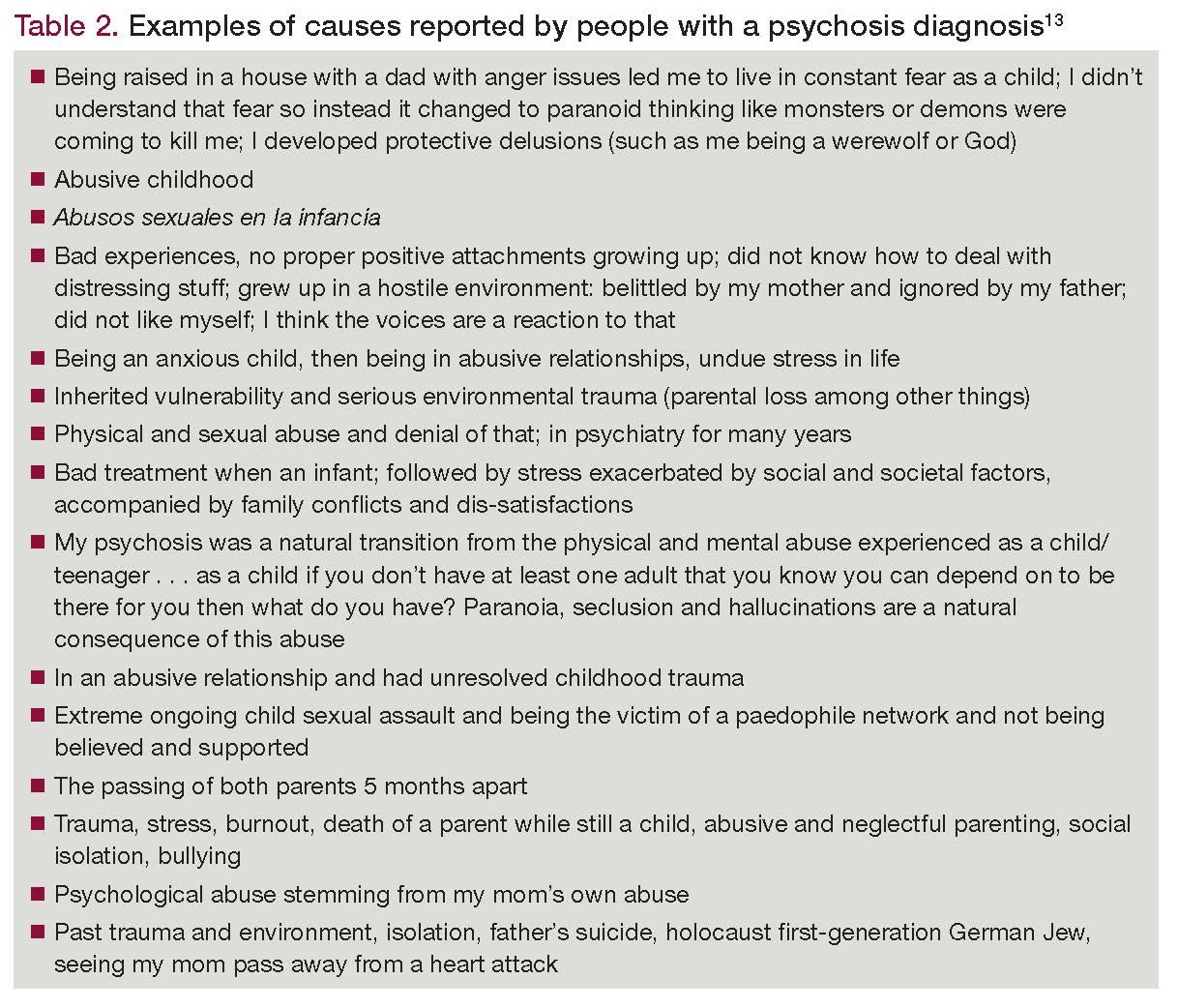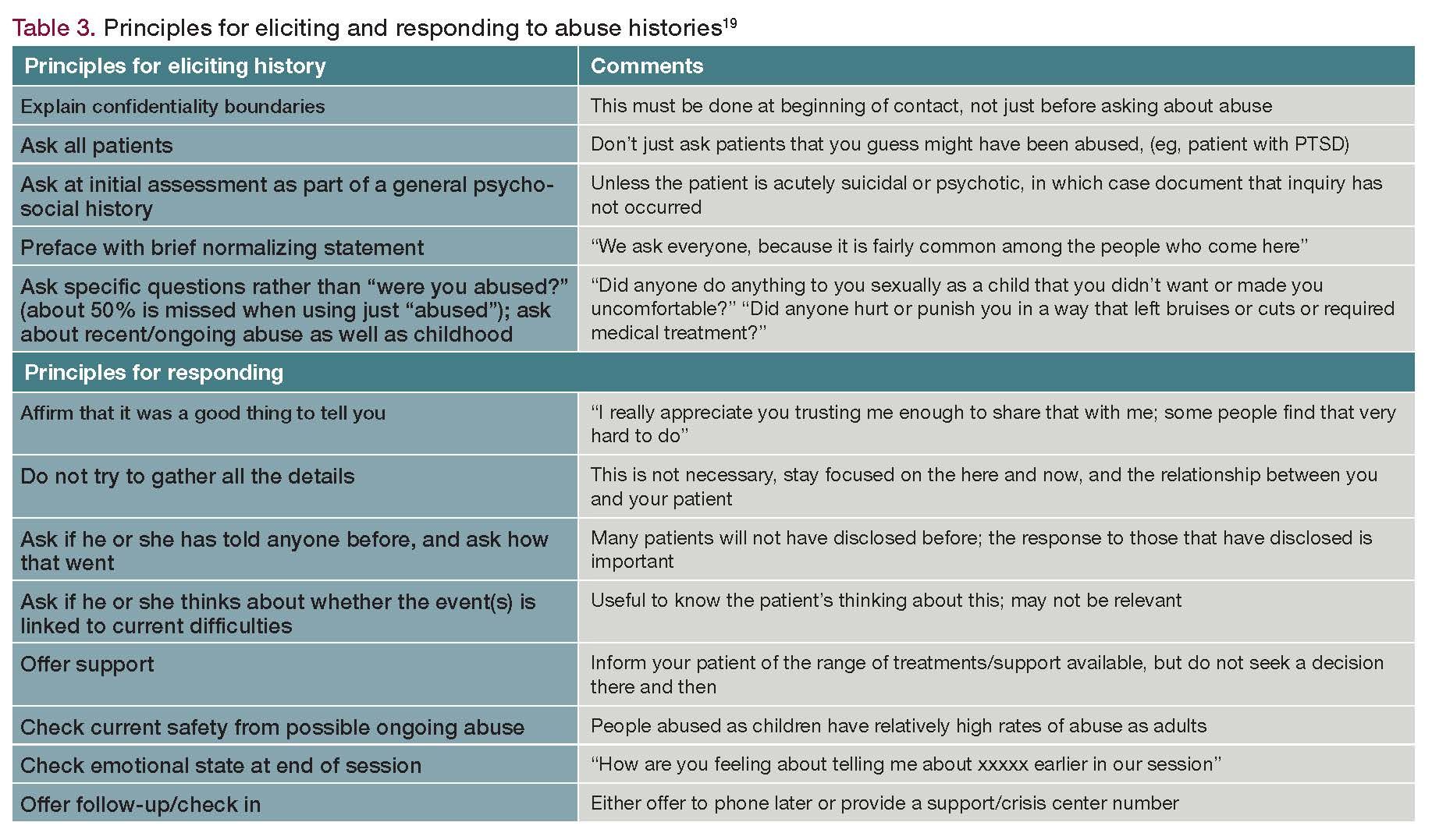Publication
Article
Psychiatric Times
Traumas, Adversities, and Psychosis: Investigating Practical Implications
Author(s):
Childhood adversities can play a causal role in the development of psychosis and psycho-social interventions can be helpful.
ACTIVITY GOAL
The goal of this activity is to understand that childhood adversities can play a causal role in the development of psychosis and that psycho-social interventions can be helpful when this is the case, including Cognitive Behavioral Therapy for Psychosis and Hearing Voices Groups.
LEARNING OBJECTIVES
After engaging with the content of this CME activity, you should be better prepared to:
1. Develop a basic understanding of the research literature regarding the relationship between childhood adversities and psychosis.
2. Be aware of the need for trauma-informed services and to ask about abuse and other adversities.
3. Consider the basic principles of cognitive behavioral therapy for psychosis.
4. Recognize the existence of Hearing Voices Groups in the US and around the world, and their basic tenets.
TARGET AUDIENCE
This continuing medical education (CME) activity is intended for psychiatrists, psychologists, primary care physicians, physician assistants, nurse practitioners, and other health care professionals who seek to improve their care for patients with mental health disorders.
ACCREDITATION/CREDIT DESIGNATION/FINANCIAL SUPPORT
This activity has been planned and implemented in accordance with the accreditation requirements and policies of the Accreditation Council for Continuing Medical Education (ACCME) through the joint providership Physicians’ Education Resource®, LLC and Psychiatric Times. Physicians’ Education Resource®, LLC is accredited by the ACCME to provide continuing medical education for physicians
Physicians’ Education Resource®, LLC designates this enduring material for a maximum of 1.5 AMA PRA Category 1 Credits™. Physicians should claim only the credit commensurate with the extent of their participation in the activity.
This activity is funded entirely by Physicians’ Education Resource®, LLC. No commercial support was received.
OFF-LABEL DISCLOSURE/DISCLAIMER
This CME activity may or may not discuss investigational, unapproved, or off-label use of drugs. Participants are advised to consult prescribing information for any products discussed. The information provided in this CME activity is for continuing medical education purposes only and is not meant to substitute for the independent clinical judgment of a physician relative to diagnostic or treatment options for a specific patient’s medical condition.
The opinions expressed in the content are solely those of the individual faculty members and do not reflect those of Physicians’ Education Resource®, LLC.
FACULTY, STAFF, AND PLANNERS’ DISCLOSURES
The authors, the peer reviewer, and the staff members of Physicians’ Education Resource®, LLC and Psychiatric Times have no relevant financial relationships with commercial interests.
For content-related questions email us at PTEditor@mmhgroup.com; for questions concerning the accreditation of this CME activity or how to claim credit, please contact info@gotoper.com and include Traumas, Adversities, and Psychosis: Investigating Practical Implications in the subject line.
HOW TO CLAIM CREDIT
Once you’ve read the article, please use the following URL to evaluate and request credit https://education.gotoper.com/activity/ptcme20jul. If you do not already have an account with PER® you will be prompted to create one. You must have an account to evaluate and request credit for this activity.
Premiere Date: July 20, 2020
Expiration Date: February 20, 2022
This activity offers CE credits for:
1. Physicians (CME)
2. Other
All other clinicians either will receive a CME Attendance Certificate or may choose any of the types of CE credit being offered.

SIGNIFICANCE FOR PRACTICING PSYCHIATRISTS
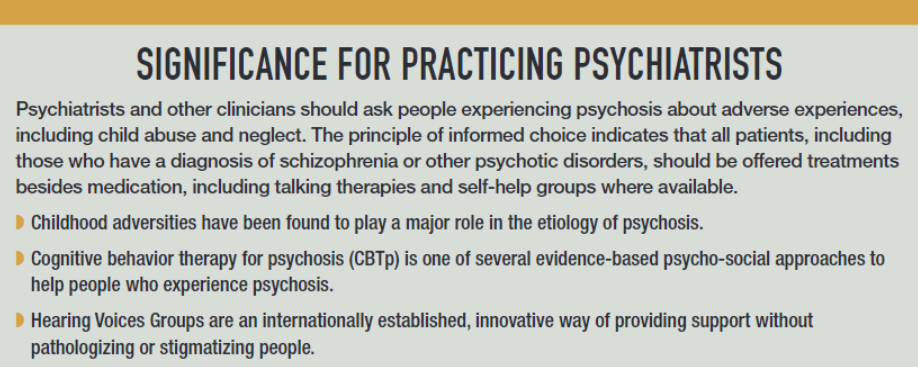
The notion that bad things happen that can drive us “crazy” has been with us for centuries. The first meta-analysis of research on the topic did not appear, however, until 2012.1 It involved the 41 most robust studies at the time, including 18 comparisons of patients with psychosis and control participants without psychiatric disorders, 10 prospective studies, and 8 general population surveys. The researchers found that psychosis was 2.8 times more likely to develop in people who had suffered one or more childhood adversities. The odds ratios for 6 specific adversities were: sexual abuse, 2.4; physical abuse, 2.9; emotional abuse, 3.4; neglect, 2.9; bullying, 2.4; parental death, 1.7. Dose response was seen in 9 of the 10 studies that tested for it. For example, a survey of 8580 people found that those subjected to one form of adversity were 1.7 times more likely to have a diagnosis of a psychotic disorder, compared with 18 times more likely for 3 adversities, and 193 times for 5.2
The biological, social, and psychological mediators of the relationship have been explored.3,4 The content of hallucinations and delusions is often related, directly or metaphorically, to childhood traumas (Table 1).5-8 The range of childhood adversities that have been found to play a causal role includes sexual abuse, incest, physical abuse, neglect, poverty, loss (eg, of parents), bullying, being fostered/adopted, or a combination of any of these.1-7,9,10 Relationships between specific traumas or adversities and specific psychosis symptoms have been investigated.10,11 The Traumagenic Neurodevelopmental Model of psychosis maps the similarities between the brains of traumatized children and adults diagnosed with schizophrenia.4
Psychiatrist Sir Robin Murray12, one of the UK’s leading psychosis researchers, acknowledged:
In the last 2 decades, it has become obvious that child abuse, urbanization, migration, and adverse life events contribute to the etiology of schizophrenia and other psychoses. This has been a big shift for me! My preconceptions had made me blind to the influence of the social environment.
A recent online survey explored the causal beliefs of 701 people, from 30 countries, taking antipsychotics.13 On a scale from 1 (purely biological) to 5 (purely social), the mean score was 4.2. The most common theme emanating from a thematic analysis was “social” (50%), followed by “psychological” (12%). The words trauma or traumatic were used by 214 people (30%), abuse or neglect were reported by 146 (21%), and loss by 46 (7%). Table 2 presents examples of such.
A report from a large epidemiological study concluded: “Adverse childhood experiences among people with psychosis are common. . . . Mental health professionals should routinely enquire about all types of adversities in this group and provide effective service responses.”14 Unfortunately, recent findings indicate that most internation users of mental health services are never asked about trauma or abuse, that services often fail to respond therapeutically to disclosures thereof, and that people with psychosis fare particularly badly on both counts.15,16
Contrary to some claims, patients who have a diagnosis of schizophrenia or other psychotic disorders are no more likely to falsely allege abuse than anyone else.17 Another belief masking the relationship is the backwards/circular logic notion that once trauma is identified in the life of someone experiencing psychosis, the diagnosis should change to posttraumatic stress disorder.
Ideally, what is required is a trauma-informed approach, a strategy pioneered in the US.18 The key components are recognition by all clinical staff that most mental health problems (including psychosis) can be conceptualized and treated through a trauma and/or adversity lens, and understanding that re-traumatization via force and compulsion is to be avoided. For many mental health professionals, the first step is learning when and how to ask about events like childhood abuse and neglect, and how to respond therapeutically to disclosures.15,16,19 Table 3 presents the principles underpinning how to effectively elicit information about abuse and therapeutic responses to disclosures, whether spontaneous or as a result of asking a patient.19
A range of treatment models are well suited to address trauma and psychosis, including psychodynamic psychotherapy, open dialogue, family therapy, acceptance and commitment therapy, and, of course, trauma therapy, which was pioneered in the US by Judith Herman, MD.20-22 There are 2 other approaches, both of which are particularly well established in the UK.
Cognitive behavioral therapy for psychosis
CBT for psychosis (CBTp) is a collaborative and problem-orientated approach, working toward goals identified by the patient.23 Given the prevalence of adversity and childhood/adult trauma, it is unsurprising that a significant proportion of the work involves trauma-focused interventions. There is a recognition that CBTp should address traumatic experiences and should acknowledge and validate the influence such experiences have on current mental health.24
CBTp must be delivered in the context of a good therapeutic relationship, and the interpersonal effectiveness of the therapist is important. CBTp emphasizes the normalization of psychotic experiences. It provides information regarding prevalence and causation to help people understand that experiences such as hearing voices and paranoid thoughts may be more common than people expect and can be understandable responses to life events such as interpersonal trauma, bereavement and loss, and substance use. This approach helps to reduce distress and internalized stigma as well as promote empowerment.
CBTp often involves the development of new coping strategies to reduce distress and increase functioning. These include trauma-focused approaches such as grounding techniques to manage trauma sequalae (eg, flashbacks, unwanted memories) and dissociative experiences. CBTp helps people explore the meaning of traumatic events, with an emphasis on reduction of self-blame, guilt, and shame by re-evaluation, evidential analysis, and development of alternative narrative accounts. It can include contextualization of unprocessed trauma memories using reliving approaches. Clinicians are often reluctant to treat people with psychosis with exposure to trauma memories, as they fear it might make the psychotic symptoms worse or lead to destabilization. However, recent studies have shown that such trauma-focused approaches can be integrated within CBTp and be safe and helpful.25 Another important aspect of CBTp is the emphasis on active participation by use of behavioral experiments to evaluate safety and current sense of threat, testing beliefs by changing behavior in the real world. In addition, engagement in tasks between sessions is important in relation to achieving the best outcomes.
There are more than 50 clinical trials of CBTp, with recent meta-analyses finding small to moderate effect sizes. These findings have led to it being recommended as a treatment for people who meet criteria for a diagnosis of schizophrenia and other psychoses in international guidelines.26 Specific to trauma-focused CBTp, systematic reviews conclude that it can be safe and effective in patients who have a diagnosis of psychosis and schizophrenia.27,28 Recent reviews and individual studies have also concluded that there is little evidence to suggest that trauma-focused CBTp leads to symptom exacerbations or adverse events; indeed, one study found a reduction in re-victimization compared with a waiting list condition.29
Hearing Voices Groups
Hearing Voices Groups are peer support groups for people who hear voices, see visions, or have other unusual sensory experiences. The groups are a survivor-led initiative that aims to create a safe space to talk about difficult experiences without fear of judgement or stigmatization. They originated in the Netherlands during the late 1980s as a result of the work of Professor Marius Romme, MD, PhD, (social psychiatrist), Sandra Escher, PhD, (journalist/researcher), and Patsy Hague (voice-hearer). There are now national networks of groups in 34 countries including the US (www.hearingvoicesusa.org), England, Serbia, Brazil, Japan, Italy, and Australia. Groups are in inpatient wards, forensic units, prisons, immigration and removal centers, child and adolescent mental health centers, and the general community. National networks are connected through the International Hearing Voices Movement supported by the UK-registered charity Intervoice (www.intervoiceonline.org). This organization includes online networking and an annual International Hearing Voices Congress for voice hearers, their loved ones, clinicians, and academics.
Rather than provide treatment, Hearing Voices Groups prioritize connection and exploration.30 The role of the facilitators, therefore, is to “lead by listening,” supporting the group’s safety and development by encouraging collaborative decision-making and an ethos of mutual support.31 Facilitators often have personal experience of hearing voices but also include mental health professionals and other allies. A key tenet of is a commitment to respect people’s right to understand their experiences in their own way.32 This can be difficult for clinicians who feel that unusual or delusional explanations should be challenged, especially in acute psychosis. However, given both the denial of trauma many survivors fear, and the way trauma and adversity can relate to themes within psychosis, rejecting fragmentary or confusing narratives risks also rejecting the person’s truths.5-8,33 Just as collective sharing of trauma narratives can create “a common bond of humanity when we understand that we come to the table of dialogue with different kinds of trauma, all of which are important,”34 the explicit pluralism of Hearing Voices Groups may provide a safe structure for members to hear and be heard. According to a survey of members of English Hearing Voices Groups, although 95% were mental health service users, the strongest results included members feeling that groups provide a safe and confidential space to discuss difficult things, and support that is unavailable elsewhere.35
Not considered an intervention in itself, the research around Hearing Voices Groups remains limited.36 However, the small-scale research paints a consistent picture. The groups provide
- a sense of belonging and connection37-39
- acceptance of one’s whole person37-40
- increased ability to talk about the voices37-40
- increased understanding of one’s experience36,38
- an increased engagement with coping strategies37,38
These potential benefits complement the phased approach to recovery from trauma: safety, exploration, and (re)connection.22
Hearing Voices Groups are not a panacea. Like all approaches, they are not universally helpful, with a small minority of participants finding that they experience “small negative shifts” after attending group meetings and feeling certain topics can be marginalized.37,39 Although 35% of the respondents to the English Hearing Voices Groups survey found groups distressing at times, the extent of the benefits endorsed in the survey suggest that groups can be helpful despite the challenges of discussing difficult material.35 Because the discussion in the groups is often difficult (eg, trauma, adversity) and such challenges are an inherent aspect of these groups it differentiates them from other social gatherings.40 For those who wish to attend them, Hearing Voices Groups can support people with a diagnosis indicative of psychosis and can have particular benefits for those with experience of trauma.
Conclusion
We trust this brief introduction noting how traumas and adversities can contribute to psychosis as well as the challenging but rewarding nature of person-centered responses is helpful. For readers wishing to learn more, there are several worthy books to consider. Similarly, the International Society for Psychological and Social Approaches to Psychosis may also be of interest.21-23,42-44
Recently, the Hearing Voices Network—England, published the article, “COVID-19: How Can We Support Each Other (and Ourselves),” which offers sources of support and information for people who hear voices.45 Much of the information contained therein is relevant for the rest of us, including health care professionals.
CME POST-TEST
Posttest, credit request forms, and activity evaluations must be completed online at https://education.gotoper.com/activity/ptcme20jul (requires free account activation), and participants can print their certificate or statement of credit immediately (80% pass rate required). This website supports all browsers. For PER’s privacy policy, please visit https://www.gotoper.com/privacy.
PLEASE NOTE THAT THE POSTTEST IS AVAILABLE ONLINE ONLY ON THE 20TH OF THE MONTH OF ACTIVITY ISSUE AND FOR 18 MONTHS AFTER.

References
1. Varese S, Smeets F, Drukker M, et al. Childhood adversities increase the risk of psychosis: a meta-analysis of patient-control, prospective- and cross-sectional cohort studies. Schizoph Bull. 2012;38:661-671.
2. Shevlin M, Houston J, Dorahy M, et al. Cumulative traumas and psychosis: an analysis of the National Comorbidity Survey and the British Psychiatric Morbidity Survey. Schizophr Bull. 2008;34:193-199.
3. Alameda L, Rodriguez V, Ewan C, et al. A systematic review on psychological and biological mediators between adversity and psychosis: potential targets for treatment. medRXiv. 2020.
4. Read J, Fosse R, Moskowitz A, et al. The traumagenic neurodevelopmental model of psychosis revisited. Neuropsychiatry. 2014;4:65-79.
5. Heins T, Gray A, Tennant M. Persisting hallucinations following childhood sexual abuse. Austr NZ J Psychiat. 1990;24:561-565.
6. Read J, Agar K, Argyle N, et al. Sexual and physical abuse during childhood and adulthood as predictors of hallucinations, delusions and thought disorder. Psychol Psychother Theory Res Pract. 2003;76:1-22.
7. Read J, Argyle N. Hallucinations, delusions, and thought disorder among adult psychiatric inpatients with a history of child abuse. Psychiatr Serv. 1999;50:1467-1472.
8. Waddingham R. Bad me? Learning from, and living with, toxicity. Psychosis. 2017;9:187-190.
9. Read J. Childhood adversity and psychosis: from heresy to certainty. Read J, Dillon J, Eds. Models of Madness, 2nd ed. London: Routledge; 2013: 249-275.
10. Longden E, Sampson M, Read J. Childhood adversity and psychosis: generalised or specific effects? Epidemiol Psychiatr Sci. 2016;25:349-359.
11. Bentall R, Sousa P, Varese F, et al. From adversity to psychosis: Pathways and mechanisms from specific adversities to specific symptoms. Soc Psychiatry Psychiatr Epidemiol. 2014;49:1011-1022.
12. Murray R. Mistakes I have made in my research career. Schizophr Bull. 2016;43:253-256.
13. Read J. Bad things happen and can drive you crazy: the causal beliefs of 701 people taking antipsychotics. Psychiatry Res. March 2020;112754.
14. Turner S, Harvey C, Hayes L, et al. Childhood adversity and clinical and psychosocial outcomes in psychosis. Epidemiol Psychiatr Sci. 2020;29:e78
15. Read J, Harper D, Tucker I, et al. A. Do mental health services identify child abuse and neglect? A systematic review. Int J Ment Health Nurs. 2018;27:7-19.
16. Read J, Harper D, Tucker I, et al. A. How do mental health services respond when child abuse or neglect become known? A literature review. Int J Ment Health Nurs. 2018;27:1606-1617.
17. Gayer-Anderson C, Reininghaus U, Paetzold I, et al. A comparison between self-report and interviewer-rated retrospective reports of childhood abuse among individuals with first-episode psychosis and population-based controls. J Psychiatr Res. 2020;123:145-150.
18. Substance Abuse and Mental Health Services Administration. Trauma-Informed Care and Alternatives to Seclusion and Restraint. Washington, DC; 2014.
19. Read J, Hammersley P, Rudegeair T. Why, when and how to ask about child abuse. Adv Psychiatr Treat. 2007;13:101-110.
20. Bloomfield M, Yusuf F, Srinivasan R, et al. Trauma-informed care for adult survivors of developmental trauma with psychotic and dissociative symptoms: a systematic review of intervention studies. Lancet Psychiat. January 28, 2020; Epub ahead of print.
21. Read J, Dillon J, Eds. Models of Madness, 2nd edition. London: Routledge; 2013.
22. Herman J. Trauma and Recovery. New York: Basic Books; 1992.
23. Morrison A, Ed. A Casebook of Cognitive Therapy for Psychosis. London: Routledge, 2002.
24. Brabban A, Byrne R, Longden E, et al. The importance of human relationships, ethics and recovery-orientated values in the delivery of CBT for people with psychosis. Psychosis. 2016;9:157-166.
25. Keen N, Hunter E, Peters E. Integrated trauma-focused cognitive-behavioural therapy for post-traumatic stress and psychotic symptoms: a case-series study using imaginal reprocessing strategies. Front Psychiatry. 2017;8:92-99.
26. National Institute for Health and Care Excellence. Psychosis and schizophrenia in adults: treatment and management. UK: NICE; 2014.
27. Swan S, Keen N, Reynolds N, et al. Psychological interventions for post-traumatic stress symptoms in psychosis: a systematic review of outcomes. Front Psychol. 2017;8:341.
28. Brand R, McEnery C, Rossell S, et al. Do trauma-focussed psychological interventions have an effect on psychotic symptoms? A systematic review and meta-analysis. Schizophr Res. 2018;195:13-22.
29. van den Berg D, de Bont P, van der Vleugel B, et al. Trauma-Focused treatment in PTSD patients with psychosis: symptom exacerbation, adverse events, and revictimization. Schizophr Bull. 2015;42:693-702.
30. Hearing Voices Network USA. HVN-USA Charter. http://www.hearingvoicesusa.org/hvn-usa-charter. Accessed March 6, 2020.
31. Dillon J, Hornstein G. Hearing voices peer support groups: a powerful alternative for people in distress. Psychosis. 2013;5:286-295.
32. National Hearing Voices Network. HVN: A Positive Approach to Voices and Visions. http://www.hearing-voices.org/about-us/hvn-values/. Accessed December 3, 2019.
33. Hardy A, Fowler D, Freeman D, et al. Trauma and hallucinatory experience in psychosis. J Nerv Ment Dis. 2005;193:501-507.
34. Van der Merwe C, Gobodo-Madikizela P. Narrating our healing: perspectives on working through trauma. Cambridge Scholars Publishing; 2009.
35. Longden E, Read J, Dillon J. Assessing the impact and effectiveness of Hearing Voices Network self-help groups. Comm Ment Health J. 2018;54:184-188.
36. Corstens D, Longden E, McCarthy-Jones S, et al. Emerging perspectives from the hearing voices movement: Implications for research and practice. Schizophr Bull. 2014;40(Suppl 4):S285–S294.
37. Beavan V, de Jager A, dos Santos B. Do peer-support groups for voice-hearers work? A small scale study of Hearing Voices Network support groups in Australia. Psychosis. 2016;9:57-66.
38. Oakland L, Berry K. “Lifting the veil”: a qualitative analysis of experiences in Hearing Voices Network groups. Psychosis. 2014;7:119-129.
39. Payne T, Allen J, Lavender T. Hearing Voices Network groups: experiences of eight voice hearers and the connection to group processes and recovery. Psychosis. 2017;9:205-215.
40. Jones N, Marino C, Hansen M. The Hearing Voices Movement in the United States: Findings from a national survey of group facilitators. Psychosis. 2015;8:106-117.
41. Romme M, Escher S, Dillon J, et al, Eds. Living with Voices: 50 Stories of Recovery. Ross, UK: PCCS Books; 2009.
42. Moskowitz A, Schäfer I, Dorahy M, Eds. Psychosis, Trauma and Dissociation: Emerging Perspectives on Severe Psychopathology, 2nd ed. London: Wiley-Blackwell; 2019.
43. Larkin W, Morrison A, Eds. Trauma and Psychosis. London: Routledge; 2006.
44. The International Society for Psychological and Social Approaches to Psychosis: US Chapter. https://isps-us.org/. Accessed April 29, 2020.
45. Waddington R. COVID-19: how can we support each other (and ourselves)? Psychosis. 2020;12:101-105.
